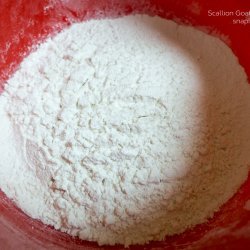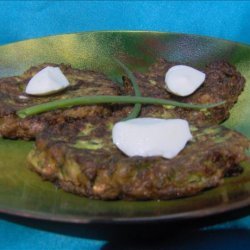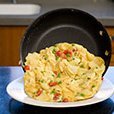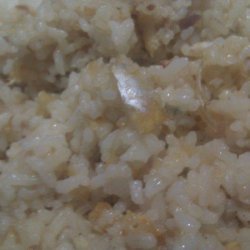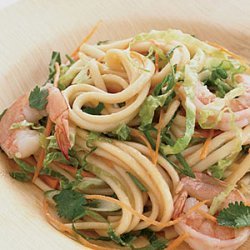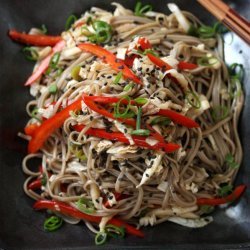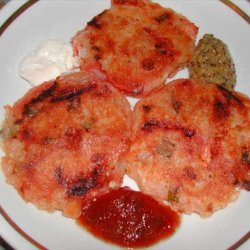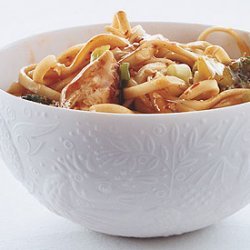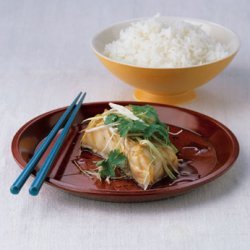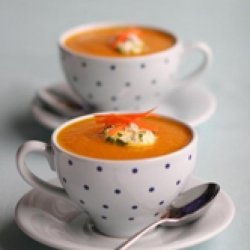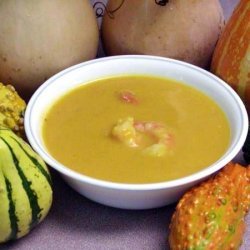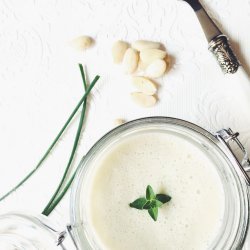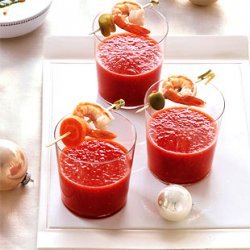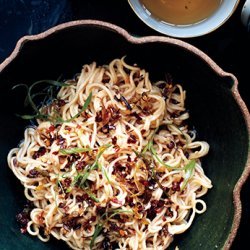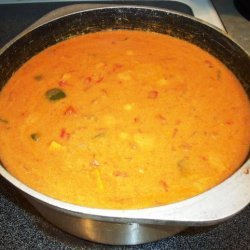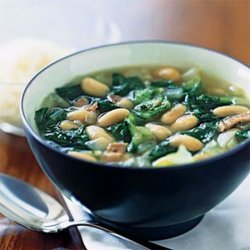Ingredients:
- 1 quart sanuki sea stock
- 2 tbsp light-colored soy sauce (usukuchi shoyu; see tips, below)
- 2 tbsp syrupy rice wine (mirin; see tips, below)
- pinch of salt , optional
- 1 recipe fresh udon noodles or 8 to 10 oz dried or semidried udon noodles , cooked ( reserve cooking water)
- 1 small knob fresh ginger, peeled and grated to yield about 2 tsp; optional
Directions:
- In a medium stockpot, combine the stock, soy sauce, and rice wine and heat to the point where small bubbles appear at the rim of the saucepan. Taste and adjust with a pinch of salt, if necessary.
- As you heat the soup, warm the bowls in which you will serve the noodles. Use a ladle to carefully scoop out boiling hot water from the pot in which the noodles were cooked and fill each serving bowl half way. Place a flat plate over the top of each bowl until ready to fill with noodles; this lid helps retain heat.
- Re-heat previously cooked, rinsed noodles: Place them in a deep, conical-shaped strainer (an Asian-style men koshi or a European-style chinois) and briefly dip them back in the boiling water two or three times. Jiggle and swish as you submerge them to separate any clusters. Lift the strainer out of the boiling water and shake and tap to remove excess water. (Or, place the noodles directly in the pot of boiling water, swish and stir, then strain them out into an ordinary colander.)
- Place the warmed noodles in the warmed bowls.
- Re-heat the seasoned soup stock until piping hot, then stir vigorously in a clockwise direction. Pour in the beaten eggs in a steady stream. Stir once in a counter-clockwise direction, then remove the pot from the stove.
- Top each portion of noodles with egg drop soup and some chopped scallions. Serve immediately with the grated ginger on the side.
- Elizabeth Andoh shares her tips with Epicurious: ·For this recipe, it's important to make the stock from scratch. Avoid the powdered and liquid instant stock products and noodle dipping sauces found in Asian grocery stores. They are typically filled with chemical additives that are of questionable health and nutritional value, and they taste dreadful. Homemade dashi takes little time and effort, and you will be well rewarded in flavor. ·Shoyu (soy sauce) is used in two varieties in the Japanese kitchen: koikuchi, the all-purpose dark variety (sold as regular soy sauce in the U.S.); and usukuchi, a saltier, lighter-colored but full-strength version (sold as light soy sauce in the U.S.). For this recipe, I recommend the light variety, but note that it is NOT the same as soy sauce labeled lite or low-sodium. (Low-sodium soy sauce, developed for the American consumer, will not give an authentic flavor.) ·Low-alcohol mirin (syrupy rice wine) is not a drinking wine. Rather, it is used in cooking as a seasoning and glazing agent. Hinode and Musashinagara are high-quality brands available in the U.S.
Nutrition Facts
| Amount Per 1 Serving | |||
| Calories | 173.13 Kcal (725 kJ) | ||
| Calories from fat | 51.38 Kcal | ||
| % Daily Value* | |||
| Total Fat | 5.71g | 9% | |
|---|---|---|---|
| Cholesterol | 186mg | 62% | |
| Sodium | 241.72mg | 10% | |
| Potassium | 89.71mg | 2% | |
| Total Carbs | 22.29g | 7% | |
| Sugars | 0.15g | 1% | |
| Dietary Fiber | 1.64g | 7% | |
| Protein | 10.19g | 20% | |
| Vitamin C | 1.4mg | 2% | |
| Iron | 1.1mg | 6% | |
| Calcium | 40.5mg | 4% | |
| Amount Per 100 g | |||
| Calories | 134.79 Kcal (564 kJ) | ||
| Calories from fat | 40 Kcal | ||
| % Daily Value* | |||
| Total Fat | 4.44g | 9% | |
|---|---|---|---|
| Cholesterol | 144.82mg | 62% | |
| Sodium | 188.2mg | 10% | |
| Potassium | 69.84mg | 2% | |
| Total Carbs | 17.35g | 7% | |
| Sugars | 0.12g | 1% | |
| Dietary Fiber | 1.28g | 7% | |
| Protein | 7.94g | 20% | |
| Vitamin C | 1.1mg | 2% | |
| Iron | 0.8mg | 6% | |
| Calcium | 31.5mg | 4% | |
* Percent Daily Values are based on a 2000 calorie diet. Your daily values may be higher or lower depending on your calorie needs.
Find out how many calories should you eat.
Get Your Recipe of Health!
Follow RecipeOfHealth on Facebook!


